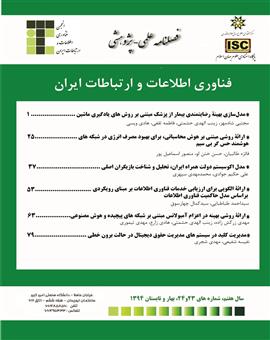مدیریت کلید در سیستمهای مدیریت حقوق دیجیتال در حالت برونخطی
محورهای موضوعی : عمومی
1 - دانشجو
2 - .صنعتی امیرکبیر
کلید واژه: مدیریت حقوق دیجیتال, رمزنگاری, مدیریت کلید, کپیبرداری,
چکیده مقاله :
با توجه به گسترش کاربرد سیستم های مدیریت حقوق دیجیتال، بکارگیری روشهایی همانند رمزنگاری و نهاننگاری اگرچه دارای برتریهایی است، ولیکن تامین کننده ی نیازمندی های سیستمهای یاد شده به عنوان مسئول توزیع امن محتوای دیجیتال نمیباشند. در همین راستا نیاز به یک روش جایگزین و یا ترکیبی به منظور حفاظت از محتوای دیجیتالی از مرحله ی تولید تا انتقال و ذخیره ی دادهها در سیستمهای مدیریت حقوق دیجیتال امری انکارناپذیر است. در این مقاله، ما مدلی برای بهبود عملکرد سیستمهای مدیریت حقوق دیجیتال پیشنهاد کردهایم، که اساس کار آن مبتنی بر رمزنگاری چند بخشی بوده و نه تنها بر انتشار و پخش اسناد نظارت و کنترل میکند، بلکه با بکارگیری دادههای متمایز و یکتا در تولید کلید، از کپیبرداری نیز به طور موثر جلوگیری مینماید. وجه تمایز اصلی رویکرد پیشنهادی با سایر روشهای به کارگرفته شده در این حوزه، استفاده از تکنیک مبهمسازی به منظور محافظت از الگوریتم تولید کلید در برابر حملات مهندسی معکوس میباشد. سیستم پیشنهادی در مقایسه با سیستم های مطرح در زمینه ی مدیریت حقوق دیجیتال معیارهای امنیتی بیشتری را پوشش می دهد.
Considering the expansion of the use of digital rights management systems, the use of methods such as encryption and encryption, although they have advantages, but they do not meet the requirements of the aforementioned systems responsible for the safe distribution of digital content. In this regard, the need for an alternative or hybrid method to protect digital content from the production stage to the transfer and storage of data in digital rights management systems is undeniable. In this paper, we have proposed a model to improve the performance of digital rights management systems, which is based on multi-part cryptography and not only monitors and controls the publication and distribution of documents, but also by using distinct and unique data in key generation. It also effectively prevents copying. The main difference between the proposed approach and other methods used in this field is the use of obfuscation technique in order to protect the key generation algorithm against reverse engineering attacks. The proposed system covers more security criteria compared to the existing systems in the field of digital rights management.


